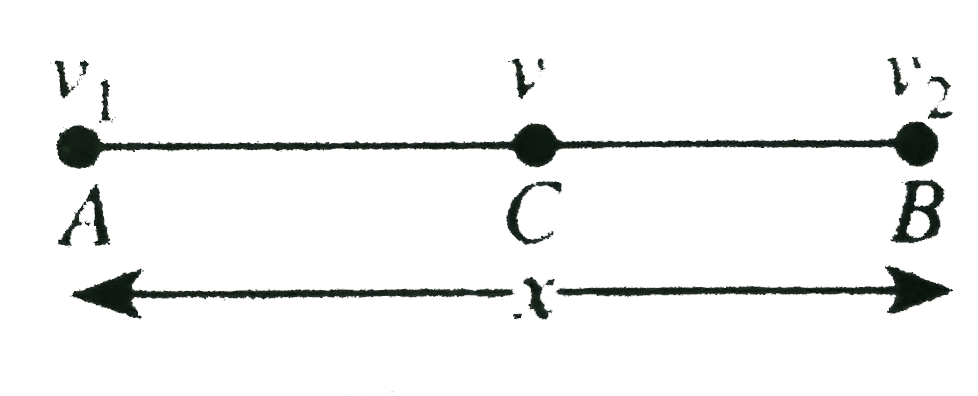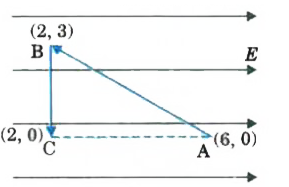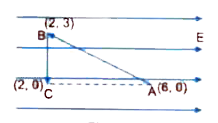Two point A and B are 2 cm apart and a uniform electric field →E acts along the straight line AB directed from A to B with E=200N⋅C−1. A particle of charge +10−6C is taken from A to B along AB.
(ii) The potential difference between A and B is Solution in Bengali
4×10−6V
1V
4V
2V
The correct Answer is:C
Step by step video, text & image solution for Two point A and B are 2 cm apart and a uniform electric field vec(E ) acts along the straight line AB directed from A to B with E = 200 N cdot C^(-1). A particle of charge +10^(-6)C is taken from A to B along AB. (ii) The potential difference between A and B is by Physics experts to help you in doubts & scoring excellent marks in Class 12 exams.
Topper's Solved these Questions
- BOOK - CHHAYA PUBLICATIONCHAPTER - ELECTRIC POTENTIAL EXERCISE - Entrance Corner (Integer answer type)3videos
ELECTRIC POTENTIAL
- BOOK - CHHAYA PUBLICATIONCHAPTER - ELECTRIC POTENTIAL EXERCISE - Examination Archive with solutions (WBCHSE)8videos
ELECTRIC POTENTIAL
- BOOK - CHHAYA PUBLICATIONCHAPTER - ELECTRIC POTENTIAL EXERCISE - Entrance Corner (Multiple correct answers type)6videos
ELECTRIC POTENTIAL
- BOOK - CHHAYA PUBLICATIONCHAPTER - ELECTRIC FIELDEXERCISE - CBSE SCANNER31videos
ELECTRIC FIELD
- BOOK - CHHAYA PUBLICATIONCHAPTER - ELECTROMAGNETIC INDUCTION & ALTERNATING CURRENTEXERCISE - CBSE SCANNER28videos
ELECTROMAGNETIC INDUCTION & ALTERNATING CURRENT
Similar Questions
Three charges -q, Q and -q are placed at equal distances on a straight line. If the total potential energy of the system is zero, then what is the ratio qQ?
02:29View SolutionWrite down the name of the physical quantity whose unit is joule/coulomb.
02:32View SolutionWhich of the following quantities do not depend on zero potential energy?
01:43View SolutionA charge q is placed at the centre of a cube of side l. What is the electric flux passing through each face of the cube?
01:51View SolutionA bar magnet is moved in the direction indicated by the arrow between two coils PQ and CD. Predict the directions of induced current in each coil.
 05:23View Solution
05:23View SolutionTwo points A and B are 2 cm apart and a uniform electric field E acts along the straight line AB directed A to B with E=200N//C . A particle of charge +10^-6C is taken from A to B along AB, Calculate a. the force on the charge b. the potential difference V_A -V_B and c.the work done on the charge by E
04:19View SolutionA particle moving with uniform acceleration from A to B along a straight line has velcities v1 and v2 at A and B respectively. If C is the mid-point between A and B then determine the velocity of the particle at C .
 .02:29View Solution
.02:29View SolutionA test charge q is moved without acceleration from A to C along the path from A to B and then from B to C in electric field E as shown in Fig. (i) Calculate the potential difference between A and C (ii) At what point [of A and C] is the electric potential more and why?
 01:42View Solution
01:42View SolutionTwo charges 4 xx 10^(-8) C and -6 xx 10^(-8) C are at points A and B respectively , 50 cm apart . The electrical potential due to them is zero on the line AB at a distance from A equal to
05:24View SolutionA particle having a mass of 10^(-2) kg carries a charge of 5 xx 10^(-8) C . The particle is given an initial horizontal velocity of 10^(5) msec^(-1) in the presence of electric field vec(E) and magnetic field vec(B) . To keep the particle moving in a horizontal direction, it is necessary that A. vec(B) should be perpendicular to the direction of velocity and vec(E) should be along the direction of velocity B. Both vec(B) and vec(E) should be along the direction of velocity C. Both vec(B) and vec(E) are mutually perpendicular and perpendicular to the direction of velocity D. vec(B) should be along the direction of velocity and vec(E) should be perpendicular to the direction of velocity
View Solutionदो बिंदु A और B एक-दूसरे से 2 सेमी की दूरी पर है । एकसमान वैधुत क्षेत्र →E,AB के समान्तर A से B की दिशा में क्रियाशील है जबकि E =200 न्यूटन/कूलॉम है । एक +10−6 कूलॉम आवेश का कण A से B की ओर AB के अनुदिश ले जाया जाता है । गणना कीजिए (i) आवेश पर बल, (ii) विभवान्तर (VA−VB) तथा (iii) आवेश पर →E द्वारा किया गया कार्य ।
03:31View SolutionTwo point A and B are 2 cm apart and a uniform electric field vec(E ) acts along the straight line AB directed from A to B with E = 200 N cdot C^(-1) . A particle of charge +10^(-6)C is taken from A to B along AB. (i) The force on the charge is
02:45View SolutionTwo point A and B are 2 cm apart and a uniform electric field →E acts along the straight line AB directed from A to B with E=200N⋅C−1. A particle of charge +10−6C is taken from A to B along AB.
(iii) The work done on the charge by →E is03:32View SolutionA test charge q is moved without acceleration from A to C along the path form A to B and then from B to C in electric field E as shown in the figure.

(i) Calculate the potential difference between A and C.
(ii) At which point (of the two) is the electric potential more and why?06:01View SolutionA test charge 'q' is moved without acceleration from A to C along the path from A to B and then from B to C in electric field E as shows in the figure. (i) Calculate the potential difference between A and C. (ii) At which point (of the two) is the electric potential more and why ?
 03:02View Solution
03:02View Solution

